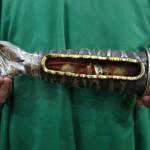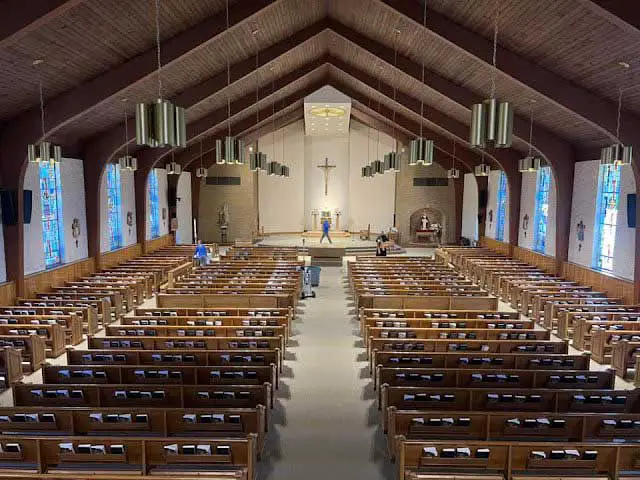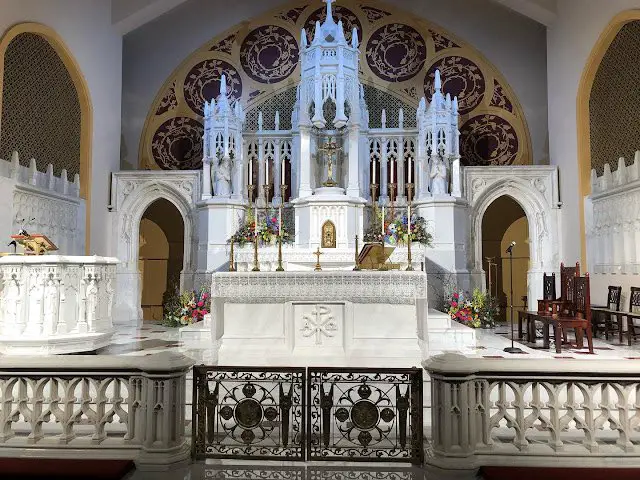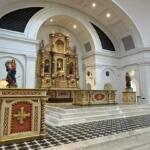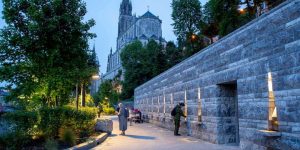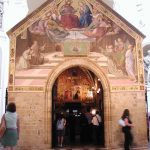Dobranoc: (Thanks Rosemarie)
Did you know that daybreak in Poland is at 4 AM? UGH! The sun is shining shortly after…….and I’m up, thinking I am late. Even with black out shades the light sneaks in. Now try going back to sleep!
We wanted to be up early anyway, since we were taking a road trip to Our Lady of Czestowchowa, about 2 hours away. This is the greatest Shrine to Our Lady in Poland. Father Tomasz said we were smart to go early (and during the week), the crowds would be small. Well, we even skipped breakfast, but didn’t get out the door until almost 8:30.
Don’t ask! We were just being leisurely. Well, to tell you the truth, we have a shower that has 10 heads. It’s like being in a car wash! Susan was in it the first night for almost 20 minutes. We have been fighting over it ever since. LOL
The traffic wasn’t too bad but there is a lot of construction going on in preparation for World Youth Day when they expect at least 2 million youths and adults to converge on Krakow. God help them. Many people in the old town and nearby are staying with relatives and renting out their homes, since there are not enough hotel rooms and apartments The U.S. has the second largest number of people coming, after Italy. That’s pretty good!
We arrived at the Shrine not expecting what we saw and were amazed at how large and beautiful it was. Our first stop was to the chapel of the Icon of the Blessed Mother and Jesus, a Black Madonna, where mass was about to begin.
We stood against a wall 1/2 half way up to the altar and could not see anything there were so many people. After mass most of them stayed to get to the altar area to pray before the famous Icon, we left and went out to get a coffee. Twenty minutes later it was like a bomb scare had gone off as the hordes of people left the Chapel.
We went back in, only to find that they had covered the Madonna Icon and closed the altar area for cleaning. Most of the people were in groups on tour buses and went to the dining hall for lunch, a perfect time to explore the marvelous shrine. See photos.
Susan and I had a quick bite at the nearest cafeteria style restaurant. It was just food, but we needed something.
We then explored the grounds and the whole Basilica and went to the adoration chapel to pray the Rosary since the Rosary chapel was closed. At the second decade, we stopped, since mass had begun in the icon chapel, and even with the doors closed in the adoration chapel, it was too loud to meditate…..it was just above the Icon.
We went down to the mass since they allowed people to walk behind the altar and the Madonna where you could venerate many relics in a glass enclosure. We waited for the gospel to be finished, took a couple of pictures and went to the back. We waited for the homily to be over and walked out the other side.
Time to depart since it was after 2 and we thought we would go to Auschwitz, but that didn’t happen, it would have been to late when we got there and we were tired from the drive.
We went to the apartment and I have to look at the pictures to remember what we did……….I’ll be right back.
Ok, I got it. Susan and I went out for dinner to this nice restaurant which, when we entered, they said the dining room was closed but we could sit on the patio. That sounded great and after we sat and ordered a glass of wine and a bottle of water they said they could give us blankets. I thought that it might snow, so we took one each, I wanted the green one. This restaurant is famous for perogies (filled dumplings…an Eastern European specialty)…….and that night they gave a lesson on making them in the garden were we sat. They filled the restaurant with the group that learned their secret.
Susan had duck and I had veal chop Milanese. Both dinners
were outstanding. With the wine we had and the rest of the meal the bill was 160 pln. After adding a generous tip, we left $48 poorer. Did I ever tell you I love Krakow ?????
It was home to shower again and relax; maybe some TV and a good nights sleep. We have a new arraignment, I’ll tell you about it later.
There is a story of Our Lady of Czestochowa below.
Dobrovnic, its close
“What you are is God’s gift to you,
What you become is your gift to God.”
May you shine before him.
Love
Susan & Tom
Prayer to Our Lady of Czestochowa
O Mother of God, Immaculate Mary, to thee do I dedicate my body and soul,
all my prayers and deeds, my joys and sufferings, all that I am an all that I have.
With a joyful heart I surrender myself to thy love. To thee will I
devote my services of my own free will for the salvation of mankind, and for the help of the Holy Church whose Mother thou art.
From now on my only desire is to do all things with thee, through thee,
and for thee. I know I can accomplish nothing by my own strength, whereas
thou can do everything that is the will of thy Son, Our Lord Jesus Christ.
Thou are always victorious. Grant, therefore, O Helper of the Faithful, that
my family, my parish, and my country might become in truth the Kingdom where
thou reignest in the glorious presence God the Father, God the Son, and
God the Holy Spirit, forever and ever.
Amen.
The Story of Our Lady of Czestochowa
The Monastery of Jasna Gora in Czestochowa, Poland, is the third-largest
Catholic pilgrimage site in the world. Home to the beloved miraculous icon
of Our Lady of Czestochowa, the monastery is also the national shrine of
Poland and the center of Polish Catholicism.
Timeline
According to tradition, the icon of Jasna Góra was painted by Luke the
Evangelist on a tabletop built by Jesus himself, and the icon was discovered
by St. Helen, mother of Emperor Constantine and collector of Christian
relics in the Holy Land. The icon was then enshrined in the imperial city of
Constantinople, according to the legend, where it remained for the next 500
years.
803
The painting is said to have been given as a wedding gift from the
Byzantine emperor to a Greek princess, who married a Ruthenian nobleman. The image
was then placed in the royal palace at Belz, where it remained for nearly
600 years.
1382
History first combines with tradition upon the icon’s arrival in Poland
with a Polish army fleeing the Tartars, who had struck it with an arrow.
1386
Legend has it that during the looting of Belz, a mysterious cloud
enveloped the chapel containing the image. A monastery was founded in Czestochowa
to enshrine the icon, and soon King Jagiello built a cathedral around the
chapel containing the icon.
1430
Hussites (pre-Reformation reformers) attacked the monastery, slashed the
Virgin’s face with a sword, and left it desecrated in a puddle of blood and
mud.
It is said that when the monks pulled the icon from the mud, a miraculous
fountain appeared, which they used to clean the painting. The icon was
repainted in Krakow, but both the arrow mark and the gashes from the sword were
left and remain clearly visible today.
1655
The miracle for which the Black Madonna of Czestochowa is most famous
occurred, when Swedish troops were about to invade Czestochowa. A group of
Polish soldiers prayed fervently before the icon for deliverance, and the
enemy retreated.
1656
King John Casimir declared Our Lady of Czestochowa “Queen of Poland” and
made the city the spiritual capital of the nation.
1717
Pope Clement XI officially recognized the miraculous nature of the image.
September 15, 1920
The Virgin again came to the aid of her people, when the Soviet Russian
Red Army gathered on the banks of the Vistula River, preparing to attack
Warsaw. The citizens and soldiers fervently prayed to Our Lady of Czestochowa
and on the Feast of Our Lady of Sorrows, she appeared in the clouds above
Warsaw. The Russians were defeated in a series of battles later dubbed the
“Miracle at the Vistula.”
1925
Pope Pius XI designated May 3 a feast day in her honor.
1945
During Nazi occupation, Hilter prohibited pilgrimages to Jasna Góra, but
many still secretly made the journey. After Poland was liberated, half a
million pilgrims journeyed to Cz?stochowa to express their gratitude.
September 8, 1946
1.5 million people gathered at the shrine to rededicate the entire nation
to the Immaculate Heart of Mary. During the Cold War, Jasna Góra was a
center of anti-Communist resistance.
1979
Pope John Paul II, a native of Poland, was a fervent devotee of the Virgin
Mary and of her icon at Cz?stochowa. As pope, he made pilgrimages to pray
before the Black Madonna in 1979, 1983, 1991, and 1997.
1991
He held his Sixth World Youth Day at Czetochowa, which was attended by
350,000 young people from across Europe.
May 26, 2006
Pope Benedict XVI visited the shrine.
Miracles, Cures, and Signs
In 1430, Hussites (pre-Reformation reformers) attacked the monastery,
slashed the Virgin’s face with a sword, and left it desecrated in a puddle of
blood and mud.
It is said that when the monks pulled the icon from the mud, a miraculous
fountain appeared, which they used to clean the painting. The icon was
repainted in Krakow, but both the arrow mark and the gashes from the sword were
left and remain clearly visible today.
In 1655, The miracle for which the Black Madonna of Czestochowa is most
famous occurred, when Swedish troops were about to invade Czestochowa. A
group of Polish soldiers prayed fervently before the icon for deliverance, and
the enemy retreated.
On September 15, 1920, the Virgin again came to the aid of her people,
when the Soviet Russian Red Army gathered on the banks of the Vistula River,
preparing to attack Warsaw. The citizens and soldiers fervently prayed to
Our Lady of Czestochowa and on the Feast of Our Lady of Sorrows, she appeared
in the clouds above Warsaw. The Russians were defeated in a series of
battles later dubbed the “Miracle at the Vistula.”
May God Bless Each and Every One Of You!
Tom & Susan Melillo
Palm Beach Gardens, FL 33418 (USA)
E-Mail:
_TSMelillo13@aol.com_ (mailto:TSMelillo13@aol.com)

